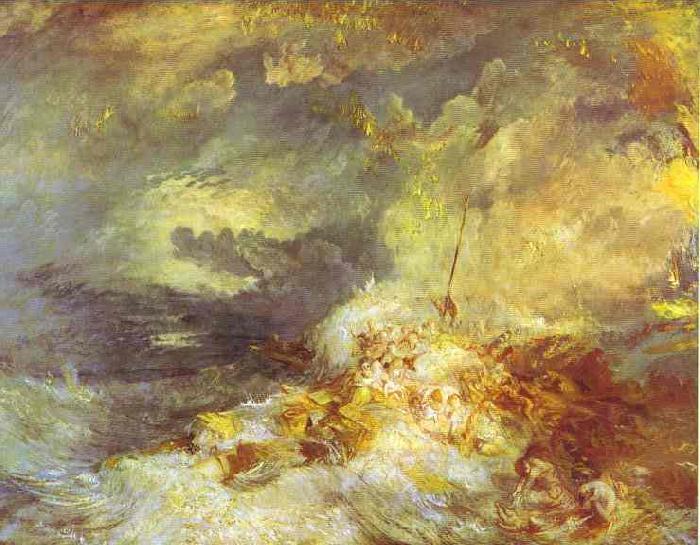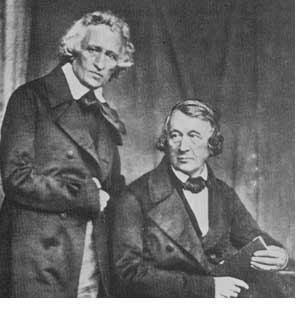Romanticism:
Involved an emphasis on human thought and feeling, and the relationship between the two.
Romanticism rejected classical rules and rational order, and had a love for the unclassifiable. Romantics had a nostalgia for that which was Medieval.
In the arts, Romanticism marked a change from the classical rules to themes that were more emotional and spiritual. Romanticism was the rejection of Neoclassicism, and a departure from the importance such placed on order, balance, harmony, and rationality.
Examples of Art: John Constable's Malvern Hall (1809), and J. M. W. Turner's Fire at Sea (about 1834).
 |
| Malvern Hall |
 |
| Fire at Sea |
Classical Liberalism:
Had an opposition to royalism, and emphasised man’s rights and liberties.
Classical Liberalism was motivated by that which was considered to be reasonable, modern, enlightened, efficient, and fair. Classical Liberalists had confidence in the human capacity for self government, and valued parliamentary government and public action of government bodies. Classical Liberalism was highly constitutional. They believed in freedom of the press and right to assemble, and placed importance on property rights. Economically, laissez-faire policies were favored, reinforcing a belief in free trade. In general, they had faith in the progress of humanity, and thought that change should be accomplished by legislation instead of revolution.
Radicalism, Republicanism, Socialism
These ‘isms’ were made up primarily by working class leaders and unrepresented industrial capitalists.
They looked to the root of matters rather than custom or tradition and wanted reform in prisons, rotten boroughs, poverty, peerage, and the squirearchy (Landowners with political or social influence). The intelligencia, and working-class leaders that made up these groups founded secret societies and advocated universal male suffrage and strong parliament action, and were anticlerical in belief.
Socialism: Socialists thought that existing economic systems were chaotic and unjust. They were against labor being guided for private profit thus favoring communal ownership of productive assets, such as banks, factories, machines, land, and transportation. Socialism valued ideas of harmony, coordination, and organization. Socialism strongly opposed laisssez-faire ideas that focused on increasing production, and were more concern for a fair and more equal distribution of income.
Prominent Socialist: Robert Owen

Robert Owen was an industrialist who created a model community where worker received high wages and worked reduced hours. He supported schools, housing, and stores in these communities.
Saint-Simonians:
A radical French political and social movement of
the first half of the nineteenth century, inspired by the ideas of Claude Henri
de Rouvroy, comte de Saint-Simon (1760-1825)
It favored public ownership of industrial equipment and capital, with control
vested in the hands of great captains of industry or social engineers. The
movement sought to coordinate labor resources with productive ends. The
movement created communal societies where people worked at what they were
interested in. Examples of these communities include Brooks Farm, Twin Oaks,
and New Harmony (Owens). This working class movement held hostility to the
owning classes of the bourgeoisie, and looked to social workshops where laborers
worked for themselves free from the intervention of private
capitalists.
Communism: Early communist ideas were close to those of socialism. Marx and Engels used the term to separate their variety of socialism from Utopian ideas (like Owen’s). They believed their beliefs to be more scientifically based.
 |
| Marx |
Conservatism: Conservatives upheld the institutions of monarchy, aristocracy, and the church. They opposed constitutional and representative government. A prominent conservative,British statesman and philosopher, Edmund Burke (1729-1797), believed that people must change its institutions by gradual adaptation. “A spirit of innovation is generally the result of a selfish temper and confined views. People will not look forward to posterity, who never look backward to their ancestors.” Edmund Burke
Feminism: Focused on expanding the rights of women. In 1792 Mary Wollstonecraft wrote A Vindication of the Rights of Women, which is one of the earliest works of the feminist philosophy. Egalitarian feminism stressed the ways in which women and men shared the use of reason and universal human rights. Women’s rights developed more rapidly in England and America, since French republicanism became hostile to female political activities. Women were given a subordinate position by the Napoleonic code, and French movements were focused on social, cultural, and legal issues rather than the vote.
English Feminism included people like Robert Owen, Harriet Taylor, and John Stuart Mill. In 1869 Mills wrote The Subjection of Women, with the help of Taylor, which advocated female equality to men and used the utilitarian argument that society would benefit from women if they were to enter public life.
American Feminism included the Seneca Falls Convention in 1848, and prominent American feminist Elizabeth Cady Stanton.
 |
| Mill and Taylor |
Nationalism: Western Europe
Nationalism could be seen as a deliberate program for political action toward unity, most evidently where peoples were politically divided or under a foreign rule. The idea of Volksgeist , or national spirit emerged, and actions were taken toward its preservation and advancement. Achieving the idea of a nation state would require the overthrow of most governments in Europe.
Secret societies communicated the nationalistic ideas, for example the Carbonari in Italy.
In Italy Joseph Mazzini promoted Italian Nationalism and was a Carbonari member. Mazzini (1805-1872) was an Italian nationalist whose writings spurred the movement for a unified and independent Italy. In 1831 he founded the Young Italy movement.
 |
| Mazzini |
 |
| Grimm Bros |
George Wilhelm Friedrich Hegel developed a philosophical framework for the way that history progressed. He believed change came about through a historical dialectic; a thesis (a given state of affairs), an antithesis (opposite of existing state of affairs), and a synthesis (reconciliation and fusion of the two). He believed that disunity and unity would synthesis to produce the German state. Hegelian dialectic made the examination of history more analytical and relevant, and influenced future Marxist philosophies.
| Hegel |
Friedrick
List (1789-1846), a German economist, believed that economics of England were
not suited for Germany, and that while free trade serves England, tariffs would
help develop a national culture. This showed nationalism in an economic sense, and helped develop industry within the German States.
| List |
Nationalism: Eastern Europe
Nationalism in Eastern Europe put more emphasis on cultural aspects of the population, such as the language, folktales, ballads. The tendency to write books in local languages grew.
The Slavic Revival had many contributers. Vuk Karajich emphasised grammar of languages and created a collection of songs, poetry, defined alphabets, as well as the translation of the New testament.
Adam Mickiewicz wrote poetry on Polish historical themes. Alexander I supported Russian Slavophilism, which would grow into Pan-Slavism.
No comments:
Post a Comment